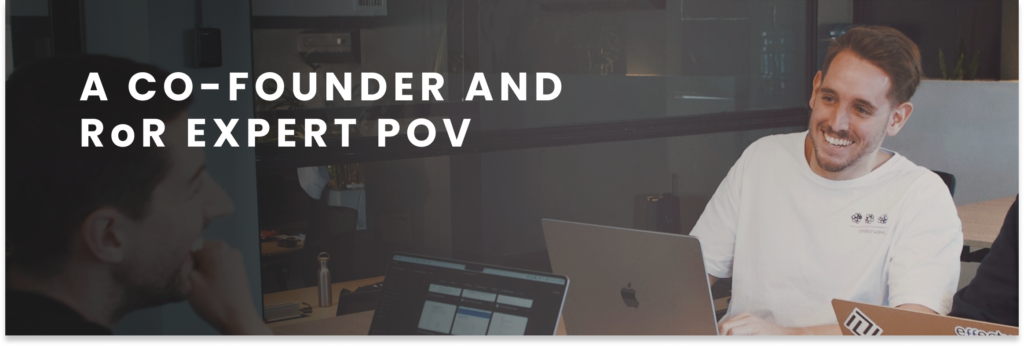Ruby on Rails turns your idea into an MVP
Ruby on Rails has been in the limelight in the current month. We have delve into why RoR is a powerful decision to get your startup running.
Now, in Effectus we invite you to explore why this is the best call for your 2025 MVP.

There’s one feature that sustains and builds credibility: being around for over 15 years.
If that’s not enough you can find a vast compendium of libraries and documentation that copilots your development process, making it a lot easier and quicker for companies.
You might be wondering… which MVPs were built with Ruby on Rails?
And, yes, there have been several notable MVPs developed using RoR over the past few years. Some examples:
- Basecamp (Reboot of the application)
- Although originally created before the last three years, Basecamp has undergone continuous development and refinement using Ruby on Rails. It serves as a project management tool with streamlined features that focus on delivering core functionalities efficiently.
- Shopify:
- While Shopify was built on Rails from its inception, it continuously evolves with new features and products utilizing RoR for MVP testing. The platform allows entrepreneurs to set up online stores quickly, demonstrating how RoR can efficiently handle e-commerce.
- Airbnb Clone Projects:
- Many startups have used Ruby on Rails to build MVPs similar to Airbnb to enter the market quickly. These projects often focus on rental listings, booking functionalities, and user profiles, showcasing rapid development capabilities.
- Discourse:
- An open-source discussion platform that started as an MVP in 2013, has continued to evolve over the years with Ruby on Rails. It focuses on community-building and engagement, showing RoR’s flexibility in handling complex user interactions.
- Hatchbox:
- A server management tool built with Ruby on Rails that simplifies application deployment and server management for developers. It started as an MVP aimed at reducing the time developers spend managing servers.
Characteristics of Successful MVPs with RoR:
- Rapid Development: Ruby on Rails’ convention over configuration allows developers to build MVPs quickly.
- Community Support: The extensive RoR community offers numerous gems (libraries) that can accelerate development.
- Scalability: While starting as an MVP, many of these applications can scale with new features and greater complexity as they grow.
These examples highlight how Ruby on Rails continues to be a popular choice for startups and projects looking to quickly validate ideas and develop MVPs.

Ruby on Rails expert Alejandro Monetti shares his insights and expertise on why RoR validates ideas fast and effortlessly for your MVP.
Why Ruby on Rails?
The “convention over configuration” approach boosts the development process. A design paradigm used by RoR devs that attempts to decrease the number of decisions that a developer makes and also following the don’t repeat yourself (DRY) principles.
Productivity, a wanted concept for teams to achieve goals and objectives. RoR’s organized structure and vast amount of available gems enable teams to be highly productive.
RoR allows a quick prototyping allowing teams and clients to iterate and have immediate feedback.
Scalability and maintenance
High frequency iteration lets teams work under agile approaches for quick adaptations and requirement changes; this is crucial to meet and exceed client and users’ expectations.
Maintaining a clean and clear code is of paramount importance for teams to understand the logic behind it. Plus, it’s a crucial best practice since it’s needed when:
- New team members join
- Refactoring is needed
- Product is released
- V2 or more
Ruby on Rails also allows seamless scalability by optimizing requests, this makes moving from an MVP to a final product seem easy and organic. You can even use microservices when the architecture turns complex.
Challenges and limitations
When developing high-concurrency applications, scalability becomes a critical consideration. As user traffic increases, there may come a point when the performance limitations of Ruby on Rails are reached, particularly in scenarios requiring extensive real-time processing or handling large volumes of requests.
It may be necessary to explore alternative technologies that can better accommodate high concurrency, such as microservices architectures or asynchronous processing frameworks like Node.js.
Performance optimization is another vital aspect that cannot be overlooked. While Ruby on Rails offers rapid development capabilities, there are situations where specific optimizations are needed to ensure a smooth user experience.
For instance, if an application experiences slow response times due to database queries or algorithm inefficiencies, developers must implement targeted optimizations.
Rounding up
In summary, Ruby on Rails presents several advantages for developing a Minimum Viable Product (MVP). Its convention over configuration approach accelerates development time, enabling startups to bring their ideas to market quickly.
The extensive library of gems allows for rapid feature implementation, reducing the need for reinventing the wheel. Additionally, Rails offers strong community support, ensuring that developers have access to resources and best practices as they build and iterate on their applications.
If you are looking to validate your business ideas, using Ruby on Rails for an MVP is a compelling choice. Embrace the opportunity to turn your vision into a reality—start building your MVP with Ruby on Rails today and lay the groundwork for your future success!

